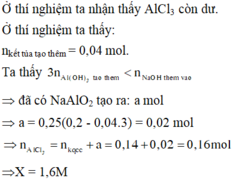Hãy nhập câu hỏi của bạn vào đây, nếu là tài khoản VIP, bạn sẽ được ưu tiên trả lời.

a, \(n_{H^+}=n_{Cl^-}=n_{HCl}=0,003\left(mol\right)\)
\(\Rightarrow\left[H^+\right]=\left[Cl^-\right]=\dfrac{0,003}{0,1}=0,03M\)
b, \(n_{H^+}=2n_{H_2SO_4}=0,05\left(mol\right)\Rightarrow\left[H^+\right]=\dfrac{0,05}{0,05}=1M\)
\(n_{SO_4^{2-}}=n_{H_2SO_4}=0,025\left(mol\right)\Rightarrow\left[SO_4^{2-}\right]=\dfrac{0,025}{0,05}=0,5M\)

\(n_{NaOH}=0,02.2=0,04\left(mol\right)\\ 2NaOH+H_2SO_4\rightarrow Na_2SO_4+2H_2O\\ a.n_{H_2SO_4}=n_{Na_2SO_4}=\dfrac{0,04}{2}=0,02\left(mol\right)\\ C_{MddH_2SO_4}=\dfrac{0,02}{0,08}=0,25\left(M\right)\\ b.\left[Na^+\right]=\dfrac{0,02.2}{0,02+0,08}=0,4\left(M\right)\\ \left[SO^{2-}_4\right]=\dfrac{0,02}{0,02+0,08}=0,2\left(M\right)\)

a) Ta có: \(n_{Al\left(NO_3\right)_3}=\dfrac{4,26}{213}=0,02\left(mol\right)\) \(\Rightarrow\left\{{}\begin{matrix}n_{Al^+}=0,02\left(mol\right)\\n_{NO_3^-}=0,06\left(mol\right)\end{matrix}\right.\)
\(\Rightarrow\left\{{}\begin{matrix}\left[Al^+\right]=\dfrac{0,02}{0,1}=0,2\left(M\right)\\\left[NO_3^-\right]=\dfrac{0,06}{0,1}=0,6\left(M\right)\end{matrix}\right.\)
b) Ta có: \(\left[Na^+\right]=0,1+0,02\cdot2+0,3=0,304\left(M\right)\)
c) Bạn xem lại đề !!

Ta thấy tỉ lệ số mol NaOH và số mol kết tủa không bằng nhau
Như vậy, phản ứng đầu chưa có kết tủa bị tan, ở phản ứng sau có kết tủa bị hòa tan
Phản ứng sau:
⇒
n
A
l
(
O
H
)
4
-
=
0
,
25
.
2
-
0
,
14
.
3
4
=
0
,
02
⇒
n
A
l
C
l
3
=
0
,
02
+
0
,
14
=
0
,
16
⇒
x
=
1
,
6
Đáp án A

a)
$BaCl_2 + Na_2SO_4 \to BaSO_4 + 2NaCl$
$n_{BaCl_2} = 0,01 = n_{Na_2SO_4} = 0,01 \Rightarrow $ Vừa đủ
$n_{BaSO_4} = n_{Na_2SO_4} = 0,01(mol)$
$m_{BaSO_4} = 0,01.233 = 0,233(gam)$
b)
$n_{NaCl} = 2n_{Na_2SO_4} = 0,02(mol)$
$V_{dd} = 0,1 + 0,2 = 0,3(lít)$
$C_{M_{NaCl}} = \dfrac{0,02}{0,3} = 0,067M$
c)
$[Na^+] = [Cl^-] = C_{M_{NaCl}} = 0,067M$
\(n_{BaCl_2}=0.1\cdot0.1=0.01\left(mol\right)\)
\(n_{Na_2SO_4}=0.2\cdot0.05=0.01\left(mol\right)\)
\(BaCl_2+Na_2SO_4\rightarrow BaSO_4+2NaCl\)
\(0.01..........0.01............0.01..............0.02\)
\(m_{BaSO_4}=0.01\cdot233=2.33\left(g\right)\)
\(C_{M_{NaCl}}=\dfrac{0.01}{0.1+0.2}=0.03\left(M\right)\)
\(\left[Na^+\right]=\left[Cl^-\right]=0.03\left(M\right)\)

Đáp án D
KOH + HCl → KCl + H2O
TH1: nHCl ≥ nKOH ⇒ Chất tan chỉ gồm KCl
nKCl = nKOH = 0,1
⇒ mKCl = 7,45 > m chất tan ⇒ loại
TH2: nHCl < nKOH
Đặt nHCl = a , nKOH dư = b ⇒ n KOH = n HCl + n KOH dư = a + b = 0,1 mol
n KCl = a mol
m chất tan = m KCl + m KOH dư = 74,5a + 56b = 6,525g
⇒ a = 0,05 mol; b = 0,05 mol
⇒ CM HCl = 0,5

a, \(\left\{{}\begin{matrix}n_{Ba^{2+}}=4.10^{-3}\left(mol\right)\\n_{Na^+}=3.10^{-3}\left(mol\right)\\n_{OH^-}=0,011\left(mol\right)\end{matrix}\right.\)
\(\Rightarrow\left\{{}\begin{matrix}\left[Ba^{2+}\right]=\dfrac{4.10^{-3}}{0,2+0,3}=0,008M\\\left[Na^+\right]=\dfrac{3.10^{-3}}{0,2+0,3}=0,006M\\\left[OH^-\right]=\dfrac{0,011}{0,2+0,3}=0,022M\end{matrix}\right.\)
b, Để trung hòa dung dịch A thì:
\(n_{H^+}=n_{OH^-}\)
\(\Leftrightarrow0,01.V_{ddHCl}=\left(0,02.2+0,01\right).0,2\)
\(\Leftrightarrow V_{ddHCl}=1\left(l\right)\)

\(n_{HCl}=0,1.0,01=0,001mol\)
\(n_{NaOH}=0,1.0,012=0,0012mol\)
NaOH+HCl\(\rightarrow\)NaCl+H2O
\(n_{NaOH\left(pu\right)}=n_{NaCl}=n_{HCl}=0,001mol\)
\(n_{NaOH\left(dư\right)}=0,0012-0,001=0,0002mol\)
- Dung dịch sau phản ứng chứa NaOH 0,0002 mol và NaCl 0,001 mol
Vdd=100+100=200ml=0,2 lít
[Na+]=\(\dfrac{0,0002+0,0001}{0,2}=0,0015M\)
[OH-]=\(\dfrac{0,0002}{0,2}=0,001M\)
[Cl-]=\(\dfrac{0,001}{0,2}=0,005M\)